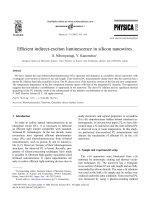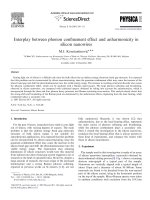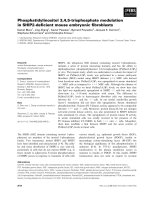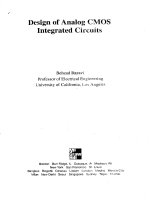Laser reflectance modulation in silicon integrated circuits
Bạn đang xem bản rút gọn của tài liệu. Xem và tải ngay bản đầy đủ của tài liệu tại đây (2.6 MB, 185 trang )
LASER REFLECTANCE MODULATION IN SILICON
INTEGRATED CIRCUITS
TEO KIAN JIN JASON
A THESIS SUBMITTED
FOR THE DEGREE OF
DOCTOR OF PHILOSOPHY
DEPARTMENT OF ELECTRICAL AND COMPUTER
ENGINEERING
NATIONAL UNIVERSITY OF SINGAPORE
2011
i
ACKNOWLEDGEMENTS
There are many people who have helped or supported me during my graduate
years, and I am deeply grateful for these gestures. There is a list of people that I
wish to explicitly express my appreciation as follows:
• Prof Jacob Phang, my academic supervisor and role model, for his guidance.
In all our interactions, he has been very meticulous and inquisitive,
maintaining a very high standard which occasionally caused anguish, but
often resulted in new breakthroughs. He has kept me honest and thorough
during my academic journey.
• Mr Chua Choon Meng, CEO of SEMICAPS, for being a great industrial
mentor through my graduate years. He has provided invaluable insights into
the needs of the FA industry with lengthy technical discussions that often
stretched into the nights.
• The staff of SEMICAPS for supporting my research efforts with world-class
equipment and facilities. Special thanks go to Lian Ser, Wah Peng, Soon
Huat, Wei Kok, Nelson, Carlson, Rane, Daniel, Michelle, Lina, Edwards and
Jennifer.
ii
• Mrs Ho Chiow Mooi, the principal laboratory officer and the staff of the Centre
for Integrated Circuit Failure Analysis (CICFAR) for providing excellent
administration and logistics support throughout my PhD candidature.
• My fellow peers at CICFAR who have provided samples, encouragement and
moral support. These include Soon Leng, Alfred, Szu Huat, Heng Wah,
Dmitry and Cong Tinh.
• My grandmother, parents and sister for their ceaseless support.
• And most of all to my wife, Maria for her support in my whole graduate
program and providing me with the greatest joy of my life by giving birth to
Sarah.
iii
TABLE OF CONTENTS
Page
ACKNOWLEDGEMENTS i
ABSTRACT viii
LIST OF ABBREVIATIONS x
LIST OF SYMBOLS xii
LIST OF TABLES xv
LIST OF FIGURES xvi
Chapter 1 : Introduction
1
1.1 Failure Analysis 1
1.2 Fault Localization Techniques 2
1.2.1 Photon Emission Microscopy 2
1.2.2 Scanning Optical Microscopy 3
1.3 Frontside and Backside Failure Analyses 3
1.4 Failure Analysis Roadmap 5
1.5 Backside Timing Measurement 8
1.5.1 Laser Voltage Probing 8
1.5.2 Time Resolved Emission 9
1.6 Backside Temperature Measurement 10
1.7 Project Motivation 13
Chapter 2 : Review of Reflectance Physics
17
2.1 Absorption 17
2.1.1 Absorption Coefficient Variation with Incident Photon Energy 18
iv
2.1.2 Absorption Coefficient Variation with Doping Concentration 20
2.1.3 Absorption Coefficient Variation with Temperature 20
2.1.4 Absorption Coefficient Variation with Electric Field 21
2.1.5 Absorption Coefficient Variation with Free Carrier Concentration 23
2.2 Refractive Index 24
2.2.1 Refractive Index Variation with Temperature 25
2.2.2 Refractive Index Variation with Electric Field 25
2.2.3 Refractive Index Variation with Free Carrier Concentration 27
2.3 Reflectance Modulation for MOS Transistor 28
2.3.1 MOS Device Operations 29
2.3.2 Single Abrupt Junction Model 33
2.3.3 Pseudo-Two-Dimensional Model by Ko 34
Chapter 3 : Review of Reflectance Modulation Systems and
Techniques
37
3.1 Flux-based CCD Systems 37
3.2 Single-laser-beam Photodiode Systems 39
3.2.1 AM using Single Pulsed Laser with Fixed Optical Beam 41
3.2.2 AM using Single CW Laser with Fixed Optical Beam 43
3.2.3 AM using Dual CW Laser with Fixed Optical Beam 46
3.2.4 AM using Single CW Laser with Scanning Optical Beam 48
3.2.5 PM using Single CW Laser with Fixed Optical Beam 50
3.2.6 PM using Dual Pulsed Laser with Fixed Optical Beam 52
3.2.6.1 Non-interferometric 52
v
3.2.6.2 Interferometric 54
3.3 Spatial Resolution 57
3.4 Telecentricity and Sample Tilt 59
3.5 Summary 60
Chapter 4 : Models and Hypothesis
62
4.1 General Laser Beam Propagation 62
4.2 Frontside Reflectance Model 65
4.3 Backside Reflectance Model 66
4.4 Reflectance Modulation due to Changes in Temperature 67
4.4.1 Impurity Doping Concentration of 10
14
cm
-3
71
4.4.2 Impurity Doping Concentration of 10
16
cm
-3
73
4.4.3 Impurity Doping Concentration of 10
18
cm
-3
74
4.5 Reflectance Modulation due to Changes in Electric Field 75
4.6 Reflectance Modulation due to Changes in Free Carrier Density 76
4.7 Reflectance Modulation Hypotheses 79
Chapter 5 : Experimental Setup and Measurement Methods
81
5.1 Experimental Setup 81
5.2 Laser Coherence 83
5.3 Probe Beam Power 85
5.4 Spatial Resolution 89
5.5 Telecentricity and Sample Tilt 89
5.6 Measurement Methods 91
5.6.1 Static Reflectance Modulation Technique 91
vi
5.6.2 Dynamic Reflectance Modulation Technique 93
Chapter 6 : Reflectance Modulation of Microscale Metal
Interconnects
95
6.1 Sensitivity 95
6.2 Reflectance Modulation at Different Applied Electrical Biases 99
6.2.1 Backside Reflectance Modulation 99
6.2.2 Frontside Reflectance Modulation 104
6.3 Backside Reflectance Modulation at Different Dimensions 105
6.4 Backside Reflectance Modulation at Different Substrate Thickness 109
6.4.1 Without an Electrical Bias 109
6.4.2 With an Electrical Bias 110
6.5 Summary 112
Chapter 7 : Characterization of MOS Transistor Channel
113
7.1 Sensitivity 113
7.2 Variation of Modulation Frequency 121
7.3 Variation of Gate Bias 124
7.4 Variation of Channel Length 128
7.5 Variation of MOS Types 131
7.6 Mask Channel Length Correction Factor 133
7.7 Analyses 136
7.7.1 Same Channel Length, Different Gate Bias 136
7.7.2 Different Channel Length, Same Gate Bias 137
7.7.3 Different MOS Types 138
7.8 Summary 139
vii
Chapter 8 : Failure Analysis Applications
141
8.1 Localization of Biased Device 141
8.2 Identification of Defective Metal Lines on Solar Modules 144
8.3 Non-invasive, High Resolution and High Sensitivity Backside
Thermal Probe
146
8.4 Non-invasive, High Resolution and High Sensitivity Backside Probe
for Characterizing MOS Devices
151
8.5 Summary 151
Chapter 9 – Conclusions and Future Works
153
9.1 Conclusions 153
9.2 Recommendations for Future Work 156
9.2.1 Reflectance Modulations of Operating Modes for Minimal-sized
Transistors
156
9.2.2 Temperature Effect of Reflectance Modulation at Different
Substrate Doping
157
9.2.3 Dynamic Reflectance Modulation using Pulsed Light Source 157
9.2.4 Reflectance Modulations at Different Incident Wavelengths 158
List of Publications
159
References
160
viii
ABSTRACT
This research aims to understand the physics governing laser reflectance
modulation and to develop novel backside characterization techniques based on
these parameters. The reflected laser intensity modulations due to changes in
the absorption coefficient and refractive index as a result of variation in the
temperature, electric field and free-carrier density have been reported. These
results are used in the modeling of the laser beam propagation.
Backside and frontside reflectance modulations at different applied electrical bias
were compared. Investigations were also carried out on backside-prepared
resistive structures at different applied electrical bias, dimensions and substrate
thicknesses. The backside reflectance intensities are observed to modulate
negatively with temperature increase. A backside reflectance model is developed
and is found to agree well with the experimental data. Subsequently, reflectance
modulation experiments were carried out on backside prepared NMOS and
PMOS transistors from the 0.18 µm process technology node with substrate
thickness of 350 µm. The MOS channel at different modes of operation is
successfully characterized for variations in gate bias, channel lengths and MOS
device types.
The results further the understanding of laser reflectance modulation of silicon
integrated circuits, and present a novel application of a sensitive, non-invasive
ix
thermal probe, as well as a novel technique to characterize the functionality of an
MOS device.
x
LIST OF ABBREVIATIONS
AC Alternating Current
AM Amplitude Modulation
BGA Ball Grid Array
BJT Bipolar Junction Transistor
CCD Charge Coupled Device
CMOS Complementary Metal-Oxide-Semiconductor
CW Continuous Wave
DC Direct Current
DPE Data Processing Engines
DRAM Dynamic Random Access Memory
DReM Differential Resistance Measurement
DUT Device Under Test
FA Failure Analysis
FFT Fast Fourier Transform
FR Faraday Rotator
FWHM Full Width Half Maximum
IC Integrated Circuits
InGaAs Indium Gallium Arsenide
InSb Indium Antimonide
IR Infrared
ITRS International Technology Roadmap for Semiconductors
LED Light Emitting Diode
LIVA Light Induced Voltage Alteration
LTP Laser Timing Probe
LVP Laser Voltage Probing
MOSFET Metal-Oxide-Semiconductor Field Effect Transistor
MPU Microprocessor Unit
NA Numerical Aperture
NIR Near Infrared
NMOS N-channel Metal-Oxide-Semiconductor
xi
OBIC Optical Beam Induced Current
OBIRCH Optical Beam Induced Resistance Change
PBS Polarizing Beam Splitter
PDP Polarization Difference Probing
PEM Photon Emission Microscopy
PICA Picosecond Imaging Circuit Analysis
PM Phase Modulation
PMOS P-channel Metal-Oxide-Semiconductor
PPM Parts Per Million
RSIL Refractive Solid Immersion Lens
SCOBIC Single Contact Optical Beam Induced Current
SEM Scanning Electron Microscope
Si Silicon
SIL Solid Immersion Lens
SNR Signal-to-Noise Ratio
SOI Silicon-on-Insulator
SOM Scanning Optical Microscopy
TBIP Thermal Beam Induced Phenomena
TIVA Thermally Induced Voltage Alteration
TRE Time-Resolved Emission
VLSI Very Large Scale Integration
VR Variable Retarder
VSR Velocity Saturation Region
xii
LIST OF SYMBOLS
α
Absorption coefficient
fc
α
Absorption coefficient for free-carrier absorption
p
α
Absorption coefficient for phonon-assisted absorption
A
N
Acceptor charge density
p
ω
Angular phonon frequency
ω
Angular photon frequency
k Boltzmann constant
Si
α
∆
Change in absorption coefficient of silicon
e
N∆
Change in free electron density
h
N∆
Change in free hole density
Si
n∆
Change in refractive index of silicon
L Channel length
W Channel width
A Constant which depends on density-of-states, effective mass and
temperature
B Constant which depends on the free carrier effective mass and
mobility
L
∆
Depletion layer width
Ko
L∆
Depletion layer width for pseudo-two-dimensional model by Ko
saj
L∆
Depletion layer width for single-sided single abrupt junction
taj
L∆
Depletion layer width for two-sided single abrupt junction
D
N
Donor charge density
DS
V
Drain voltage
DS
I
Drain current
*
e
m
Effective mass of electrons
*
h
m
Effective mass of holes
eff
L
Electrical channel length
xiii
q Electronic charge
L
f
Focal length
N Free carrier density
GS
V
Gate voltage
γ
High temperature absorption coefficient
doped
N
Impurity doping concentration
0
I
Incident laser intensity
g
E
Indirect bandgap energy
4
I
Intensity of light incident at the Material-Air interface
2
I
Intensity of light incident at the Material-Al interface
3
I
Intensity of light reflected at the Material-Al interface
1
I
Intensity of light transmitted at the Air-Material interface
5
I
Intensity of light transmitted at the Material-Air interface
j
x
Junction depth
mask
L
Mask channel length
m
E
Maximum electric field
sajm
E
,
Maximum electric field calculated using single abrupt junction
model
R Minimum resolvable spatial resolution
m
N
Mobile charge density
λ
Optical wavelength
ox
t
Oxide thickness
l
V
Output of lock-in amplifier for experimental setup
a
V
Output of low noise amplifier for experimental setup
0
I
Peak irradiance of the laser in MW.cm
-2
0
ε
Permittivity of free space
ox
ε
Permittivity of silicon oxide
Si
ε
Permittivity of silicon
xiv
peak
L∆
Position of dominant peak from the drain-end in the channel
D Pupil diameter of the objective lens
h
Reduced Planck constant
ref
V
Reference frequency input of lock-in amplifier
R Reflectance
r Reflectance coefficient
1
R
Reflectance of the Air-Material interface
n Refractive index of crystalline silicon
i
n
Refractive index of incident medium
t
n
Refractive index of transmitting medium
0
T
Room temperature
S
E
Saturated electric field
DSAT
I
Saturation drain current
DSAT
V
Saturation drain voltage
T Temperature
k Thermoreflectance coefficient
m
t
Thickness of material
s
t
Thickness of silicon substrate
T
V
Threshold voltage
t
I
Total reflected light intensity measured by the photon detector
b
I
Total reflected light intensity measured by the photon detector for
the backside reflectance model
f
I
Total reflected light intensity measured by the photon detector for
the frontside reflectance model
r
T
Transmittance
1
T
Transmittance of the Air-Material interface
P
2
β
Two-photon absorption coupling coefficient
xv
LIST OF TABLES
Page
Table 1.1 Key parameters relevant to FA extracted from ITRS
roadmap
7
Table 1.2 Comparison of laser probing and PICA techniques 10
Table 3.1 Phase versus amplitude modulation 41
Table 4.1 Reflectance modulations due to electrorefraction 75
Table 4.2 Changes in refractive index and absorption coefficient
due to variation in free electron density
76
Table 4.3 Changes in refractive index and absorption coefficient
due to variation in free hole density
77
Table 4.4 Reflectance modulation due to variation in free electron
density
77
Table 4.5 Reflectance modulation due to variation in free hole
density
78
Table 6.1 Compiled reflectance coefficients 107
Table 6.2 Reflectance coefficients for undoped substrate 108
Table 6.3 Reflectance coefficients at different substrate thickness 111
xvi
LIST OF FIGURES
Page
Fig. 1.1 SEM cross sections of an IC with (a) 2 layer metallization
and (b) 6 layer metallization
4
Fig. 1.2 Light transmittance of (a) 500 µm p-Si with different
doping concentrations and (b) p-Si at 10
19
cm
-3
with
different thicknesses
5
Fig. 1.3 ITRS technology trend based on roadmap for 2009 6
Fig. 1.4 Frequency doubling every two years 8
Fig. 1.5 Power crisis 11
Fig. 1.6 Image captured using a Xenics InSb camera 12
Fig. 2.1 Absorption coefficient versus wavelength 19
Fig. 2.2 Electro-absorption spectrum of Si 22
Fig. 2.3 Optical absorption spectra of c-Si for (a) free electrons,
and (b) free holes
24
Fig. 2.4 Electrorefraction versus wavelength 26
Fig. 2.5 Carrier refraction in c-Si at 1.3 µm wavelength 28
Fig. 2.6
I
DS
-V
DS
characteristics of NMOS device
29
Fig. 2.7 (a) Qualitative representation, and (b) free electron
density along the channel of an NMOS transistor in
inversion mode
30
Fig. 2.8 (a) Qualitative representation, and (b) free electron
density along the channel of an NMOS transistor in linear
mode
31
Fig. 2.9 (a) Qualitative representation, and (b) free electron
density along the channel of an NMOS transistor in
pinched-off mode
32
Fig. 2.10 (a) Qualitative representation, and (b) free electron
density along the channel of an NMOS transistor in
saturation mode
32
Fig. 2.11 Single-abrupt junction model 33
Fig. 2.12 Calculated electric field versus position in the channel for
both two-dimensional Poisson model and single abrupt
junction model
36
Fig. 3.1 CCD camera-based thermoreflectance system 38
Fig. 3.2 First confocal microscopy optical setup 40
Fig. 3.3 Simplified schematic of LVP system used in Intel 42
Fig. 3.4 Thermoreflectance based on reflectometry 44
Fig. 3.5 Temporal relative reflectance response of two samples to
a 1 µs, 70 mA current
46
Fig. 3.6 Laser beam deflection technique used for thin-film
thickness measurements
47
xvii
Fig. 3.7 Scanning laser-reflectance thermometry 48
Fig. 3.8 Simplified LVP measurement system 49
Fig. 3.9 (a) Backside optical probe system using reference beam
and (b) measured timing waveform of a 100MHz digital
signal
51
Fig. 3.10 Polarization Difference Probing 52
Fig. 3.11 PDP optical path 53
Fig. 3.12 Basic phase interferometer detection system 55
Fig. 3.13 Interferometric thermoreflectance setup 56
Fig. 3.14 Comparison of (top) telecentric lens (bottom) ordinary
lens
59
Fig. 3.15 Telecentric system ray diagram 60
Fig. 4.1 Reflected laser beam model 63
Fig. 4.2
Variation of R
1
, R
2
and α with temperature
68
Fig. 4.3 Absorption coefficient of n-doped Si at various doping
concentrations
69
Fig. 4.4 Absorption coefficient of p-doped Si at various doping
concentrations
70
Fig. 4.5
Variation of R
1
, R
2
and α with temperature at impurity
doping concentration of 10
14
cm
-3
72
Fig. 4.6
Variation of R
1
, R
2
and α with temperature at impurity
doping concentration of 10
16
cm
-3
73
Fig. 4.7
Variation of R
1
, R
2
and α with temperature at impurity
doping concentration of 10
18
cm
-3
74
Fig. 5.1 SEMICAPS SOM1100 optical setup 82
Fig. 5.2 (a) Backside laser-scanned image using coherent 1340
nm laser source, and (b) reflected intensity across KK’
84
Fig. 5.3 Reflected intensity across KK’ using a non-coherent
1.34µm light source
85
Fig. 5.4 Probe beam power versus supply current 86
Fig. 5.5 Current bias is (a) 150 mA, (b) 250 mA, and (c) 500 mA 88
Fig. 5.6 Differential image at sample tilt (a) 0º, (b) 3º, (c) 6º and
(d) 9º
90
Fig. 5.7 Setup for static and dynamic techniques 92
Fig. 6.1 Reflected image of resistive structure #R1 96
Fig. 6.2 (a) Reflected intensity, and (b) reflectance modulation
using the static technique across metal (M) lines and
spacing (S) of line profile AA’
97
Fig. 6.3 Reflected image of resistive structure #R2 99
Fig. 6.4 Differential reflectance modulation images of sample #R2
at an electrical bias of (a) 17 mW, (b) 37 mW and (c) 66
mW
101
Fig. 6.5 Reflectance modulation of area C for (a) 0 – 4 mW and
(b) 0 – 16 mW bias
102
xviii
Fig. 6.6 Line profile XX’ of reflected intensity for sample #R2
across metal (M) lines and spacing (S)
103
Fig. 6.7 Line profile XX’ of reflected intensity from the frontside
for sample #R2 across metal (M) lines and spacing (S)
104
Fig. 6.8 Line profile AA’ of reflected intensity for sample #R1
across metal (M) lines and spacing (S)
106
Fig. 6.9 Reflected intensities at different substrate thicknesses
and room temperature
109
Fig. 6.10 Reflected intensities at different thicknesses and
temperatures
110
Fig. 7.1
NMOS transistor with Lmask = 2µm
114
Fig. 7.2
The I
DS
-V
DS
characteristics of NMOS transistor with
L
mask
= 2 µm
115
Fig. 7.3
Pseudo-color image of ∆V
a
in area D for NMOS
transistor with L
mask
= 2 µm when both V
DS
and V
GS
are
5V, using static technique with CW laser
116
Fig. 7.4 Plot of ∆V
a
across channel YY’ using static reflectance
modulation technique and CW laser
117
Fig. 7.5 Plot of ∆V
a
across channel YY’ using static reflectance
modulation technique and pulsed laser
118
Fig. 7.6
Pseudo-color image of V
l
in area D for NMOS transistor
with L
mask
= 2 µm when V
GS
= 5V and various V
DS
, using
dynamic technique with CW laser
119
Fig. 7.7
Plot of channel YY’ for NMOS transistor with L
mask
= 2
µm, V
GS
= 5V and V
ref
= 7.33 kHz, using the dynamic
technique
120
Fig. 7.8
Plot of channel YY’ for NMOS transistor with L
mask
= 2
µm, V
GS
= 5V and V
ref
= 73.33 kHz, using the dynamic
technique
122
Fig. 7.9
Plot of channel YY’ for NMOS transistor with L
mask
= 2
µm, V
GS
= 5V and V
ref
= 733 Hz, using the dynamic
technique
124
Fig. 7.10
NMOS transistor with Lmask = 4µm
125
Fig. 7.11
The I
DS
-V
DS
characteristics of NMOS transistor with
L
mask
= 4 µm
125
Fig. 7.12 Pseudo-color image of area D for NMOS with L
mask
=4
µm and V
GS
=5V
126
Fig. 7.13 Plot of channel YY’ for NMOS transistor with L
mask
=4 µm
and V
GS
=5V
127
Fig. 7.14 Plot of channel YY’ for NMOS transistor with L
mask
=4 µm
and V
GS
=3V
128
Fig. 7.15
NMOS transistor with L
mask
= 1.4µm
129
Fig. 7.16
The I
DS
-V
DS
characteristics of NMOS transistor with
L
mask
= 1.4 µm
130
xix
Fig. 7.17 Plot of channel YY’ for NMOS transistor with L
mask
=1.4
µm and V
GS
=5V
131
Fig. 7.18
The I
DS
-V
DS
characteristics of PMOS transistor with
L
mask
= 1.4 µm
132
Fig. 7.19 Plot of channel YY’ for PMOS transistor with L
mask
=1.4
µm and V
GS
= -3V
133
Fig. 7.20
Relation between L
mask
and L
eff
134
Fig. 7.21
Plot of Resistance against L
mask
for the determination of
the correction factor
134
Fig. 7.22
Plot of L
eff
against L
mask
135
Fig. 7.23 Comparison of experimental peaks with analytical pinch-
off point for NMOS transistor with L
mask
= 4 µm and
different V
GS
136
Fig. 7.24 Comparison of experimental peaks with analytical pinch-
off point for NMOS transistors when V
GS
=5V and
different channel lengths
137
Fig. 7.25 Comparison of experimental peaks with analytical pinch-
off point for NMOS and PMOS transistors at L
mask
= 1.4
µm
139
Fig. 8.1 Backside reflected image of BJT array 142
Fig. 8.2 Differential reflectance modulation images of BJT
transistor at an electrical bias of (a) 36 mW, (b) 79 mW
and (c) 120 mW
143
Fig. 8.3 (a) Image of prototype solar module, and (b) topview
drawing
144
Fig. 8.4 Frontside reflectance modulations at (a) forward and (b)
reversed bias for good and bad metallic fingers
transformed in pseudo-color images
145
Fig. 8.5 Backside reflected image of a thermal sensor chip 147
Fig. 8.6 Backside reflectance modulation transformed in the
pseudo-color images of thermal sensor chip at a
temperature change of (a) 2.4, (b) 32.4 and (c) 53.3 K
148
Fig. 8.7 Identified defective location of power short overlayed on
reflected image using (a) TIVA, and (b) static backside
thermoreflectance technique
150
1
Chapter 1: Introduction
This introduction provides an overview of the failure analysis (FA) that is typically
used for microelectronic devices. Distinction is made between frontside and
backside FA. This is followed by a discussion on the International Technology
Roadmap for Semiconductors (ITRS) reference for 2009 to highlight the major
challenges. Brief introductions are provided for existing FA techniques in fault
localization, timing and temperature measurements to illustrate the inadequacies
of these techniques in addressing the challenges highlighted by the ITRS
roadmap. The chapter concludes with the main motivations for undertaking this
research.
1.1 Failure Analysis
Failure analysis (FA) is an integral step for the development and manufacturing
of semiconductor integrated circuits. It occurs at all stages of the manufacturing
process from design and wafer fabrication to integrated circuits (IC) packaging
and applications. Failure analysis tools are critical to the key functions of design,
product and process development, wafer production, packaging, testing and
customer returns. The microelectronic failure analysis is a sequential process
that consists of five main steps, namely, failure validation, fault localization,
sample preparation and defect tracing, defect characterization and root cause
determination [1]. It involves a thorough understanding of the failing mechanisms
and determination of its root cause.
2
1.2 Fault Localization Techniques
Fault localization is a challenge in FA [2] and is the most critical step as it sharply
reduces the area for subsequent analyses [3]. The main fault localization
techniques are based on two categories of far-field techniques, namely passive
and active techniques. The main passive technique is Photon Emission
Microscopy (PEM) [4, 5] which is based on electroluminescence and detection is
achieved with a photon-sensitive camera. The main active technique is based on
scanning optical microscopy (SOM) [6] in which a near-infrared (NIR) laser at
1.064 or 1.34 µm wavelength is used to stimulate failures that are sensitive to
carrier or thermal stimulation respectively. PEM and SOM are typically used as
complementary techniques in fault localization.
1.2.1 Photon Emission Microscopy
PEM requires the sample to be biased in normal operating mode, so that failure
sites can emit photons and then be localized. Emission of photons result from
three main radiative transition processes: (i) Inter-band electron-hole pair
recombinations, (ii) Transitions involving chemical impurities, physical defects or
deep traps, and (iii) Intra-band transitions involving hot electrons and hot holes
[4]. The emitted photons can be observed from frontside or backside prepared
samples using photon detectors [7]. Photon emissions from defective sites occur
due to leaky junctions, contact spiking, oxide leakages and silicon mechanical
damages. Given that it is relatively easy to use PEM for defect localizations, it is
widely used in industry. It should be added that photon emissions are also
3
observed from normal MOSFET in saturation mode. Hence, photon emission
sites may not necessarily correlate to fault locations [5]. Besides, not all faults
emit photons. For example, metallization failures are ohmic and do not result in
radiative recombinations.
1.2.2 Scanning Optical Microscopy
SOM uses a scanned NIR laser beam to stimulate failures which are sensitive to
thermal or carrier stimulation. At NIR 1.34 µm wavelength, the incident photons
induced localized heating as the photon energies are lower than the device
bandgap energy. The temperature variation causes a change in resistivity and
induces power alteration which can be detected by various detection techniques.
These include Optical Beam Induced Resistance Change (OBIRCH) [6, 8],
Thermally Induced Voltage Alteration (TIVA) [6, 9], Thermal Beam Induced
Phenomena (TBIP) [10], and Differential Resistance Measurement (DReM) [11].
At 1064 nm wavelength, the incident photons generate electron-hole pairs
through carrier stimulation. Techniques using this phenomenon include Optical
Beam Induced Current (OBIC) [12], Single Contact Optical Beam Induced
Current (SCOBIC) [13] and Light Induced Voltage Alteration (LIVA) [14].
1.3 Frontside and Backside Failure Analyses
In the late nineties, the frontside failure analysis became increasingly difficult due
to an increasing number of multi-level metals which prevent emitted photons at
the faults from reaching the detector and laser stimulation from reaching the
4
faulty areas. Figure 1.1 illustrates this difficulty with Scanning Electron
Microscope (SEM) cross-sectional images of ICs with 2 and 6 metallization
layers. Furthermore, the use of array input-output connection pads across the die
for higher speed devices such as ball grid array (BGA) and flip-chip packages
does not allow frontside access with full electrical functionality. These constraints
have led to the development of a new suite of backside failure analysis
techniques [15].
(a) (b)
Fig 1.1. SEM cross sections of an IC with (a) 2 layer metallization and (b) 6
layer metallization [16]
Backside localization techniques overcome these limitations by taking advantage
of the fact that backside silicon is fairly transparent to near-infrared (NIR) light as
shown in Figure 1.2. The transmittance is the highest around the silicon (Si)
bandgap of 1107 nm and decreases significantly with doping concentration and
backside thickness [6, 17]. Wavelengths below 1 µm are absorbed by the Si
substrate. Device substrates are generally thinned to about 100 µm for the
5
highest transmittance without introducing stress induced damage from the
backside preparation process.
(a) (b)
Fig 1.2 – Light transmittance of (a) 500 µm p-Si with different doping
concentrations and (b) p-Si at 10
19
cm
-3
with different thicknesses [6, 17]
For backside sample preparation, it is important to consider the doping
concentration and backside substrate thickness because they affect the
transmittance of light as shown in Figure 1.2. For instance, a highly doped
sample at a doping concentration of 10
19
cm
-3
and backside thickness of 500 µm
has transmittance less than 0.1, resulting in significant signal intensity
attenuation. In practical terms, lightly doped substrates do not require much
thinning while thinning can improve transmittance significantly for highly doped
substrates.
1.4 Failure Analysis Roadmap
The International Technology Roadmap for Semiconductors (ITRS) provides
updated roadmap of the needs and challenges facing the semiconductor industry
over the next fifteen years so that research and developmental efforts can be









